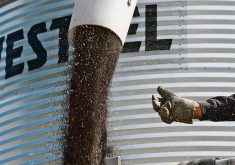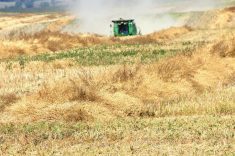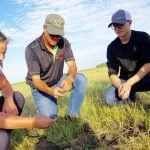A collection of Saskatchewan communities is going back to the province’s co-operative roots in an attempt to establish producer-owned integrated ethanol feedlot facilities.
The Prairie Ethanol Consortium includes representatives from Meadow Lake, Canwood-Debden, Kindersley and Bengough who are interested in building a 10,000 head feedlot in conjunction with a 25 million litre ethanol plant in each of their respective regions.
“Each of the communities are building a similar plant. We’re going to have similar issues as we go down the road and the business plans will be very similar as well,” said consortium president Barry Lewis, the economic development officer with the Northwest Regional Economic Development Authority.
Read Also

Farm Credit Canada partners with major Toronto innovation hub
A FCC parntership with MaRS Discovery District aims to solve technology problems in food supply chains.
“Working on these projects together has really increased our chances of success down the road.”
The co-operative approach has already helped secure $300,000 through the federal government’s Biofuels Opportunities for Producers Initiative, money that is being used to develop a joint business plan for the four community ventures.
Lewis estimated 70 percent of the business plan will contain common elements, while the remaining 30 percent will be site-specific concerns.
“Why would we reinvent the wheel and pay consultants to do that four times over for us?”
He anticipates the joint part of the business plan will be complete by June and the remaining individual documentation by December, leading to multiple share offerings starting in late 2007 or early 2008. The earliest construction will start is the summer or fall of 2008.
Lewis isn’t overly concerned about being late out of the gate compared to some of the projects announced last year.
“We’re taking a very slow, calculated, methodical approach to our planning. I know some of the other groups that are storming ahead and they’ve got these grandiose plans but yet at the end of the day they still haven’t turned sod and neither have we. So are they ahead of us or aren’t they?”
He said the federal government announced its incentive package in the March 19 budget and Saskatchewan won’t likely be trotting out its program until after an anticipated 2007 election call, so it’s not too late to participate in those programs.
The consortium once consisted of six community groups but Melfort and Moosomin have since dropped out to pursue private ethanol ventures. Lewis wished them well, saying any type of ethanol project is good for rural Saskatchewan, delivering $2 to $3 of spinoff economic activity for every $1 of ethanol produced.
“I don’t know when was the last time we had an opportunity like this. I can’t think of one actually,” he said.
The consortium plans to stay together long after the business plans are developed to take advantage of other synergies with their $35 to $40 million plants.
For instance, they may decide to have one general manager run all four plants due to the shortage of skilled labour. And they will jointly market their cattle and ethanol to improve their clout with retailers. Combined, the four plants will rival the size of some of the bigger projects like Husky Energy’s facility in Lloydminster, Sask.
“Marketing is going to be a real key as we move this forward,” said Lewis.















